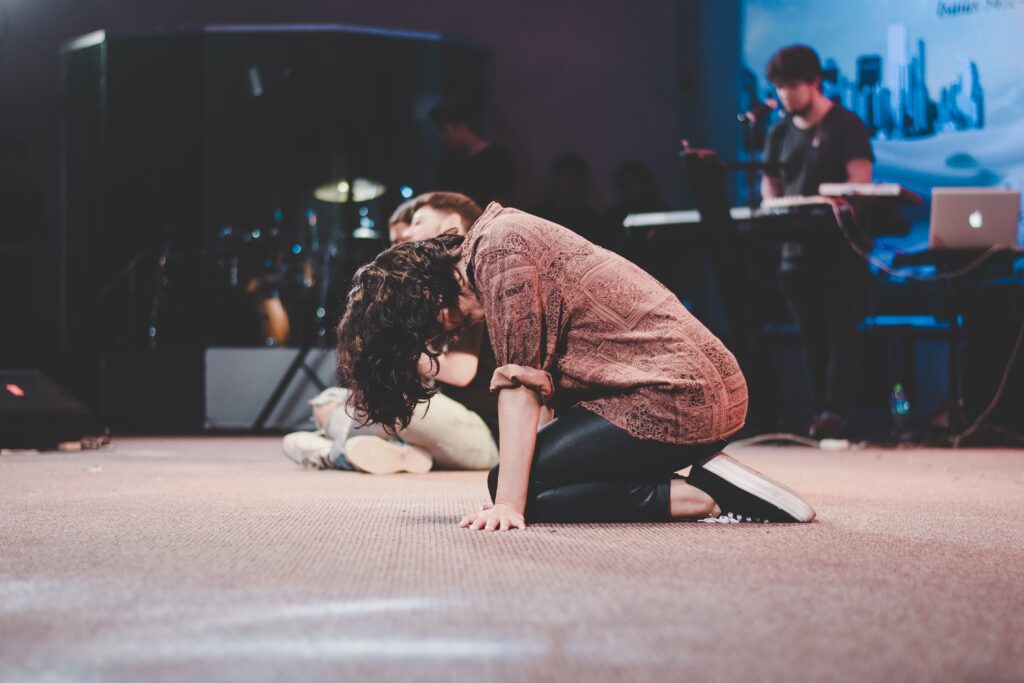
A Brief History of Spiritual Revival and Awakening in America
|
|
June 30, 2015 in Patrick Morley Blog
In describing what happened in Jonathan Edward’s Northampton, Massachusetts church in 1734, observers said, “It pleased God…to display his free and sovereign mercy in the conversion of a great multitude of souls in a short space of time, turning them from a formal, cold, and careless profession of Christianity, to the lively exercise of every Christian grace, and the powerful practice of our holy religion.”1
That’s about as clear a definition as we’ll ever get! During a revival, God supernaturally transforms believers and non-believers in a church, locale, region, nation, or the world through sudden, intense enthusiasm for Christianity.2 People sense the presence of God powerfully; conviction, despair, contrition, repentance, and prayer come easily; people thirst for God’s word; many authentic conversions occur and backsliders are renewed.
Revival and awakening are, generally, synonyms. The larger the geography a revival covers, the greater the tendency to call it an awakening.
America has a deep, rich history of revivals and awakenings.

Revivals in America: A Well-Traveled Road
The Great Awakening, 1734-43
In December 1734, the first revival of historic significance broke out in Northampton, Massachusetts, where a young Jonathan Edwards was pastor. After months of fruitless labor, he reported five or six people converted–one a young woman. He wrote, “[She] had been one of the greatest company-keepers in the whole town.”3 He feared her conversion would douse the flame, but quite the opposite took place. Three hundred souls converted in six months–in a town of only 1,100 people!4 The news spread like wildfire, and similar revivals broke out in over 100 towns.5 Starting in Philadelphia in 1739, George Whitfield’s dramatic preaching was like striking a match to the already-underway awakening. An estimated 80% of America’s 900,000 Colonists personally heard Whitfield preach.6 7 He became America’s first celebrity.8
The Second Great Awakening, 1800-1840
In 1800, only one in 15 of America’s population of 5,300,000 belonged to an evangelical church.9 Presbyterian minister James McGready presided over strange spiritual manifestations in Logan County, Kentucky. The resulting camp meeting revivals drew thousands from as far away as Ohio.10 11 Rev. Gardiner Spring reported that for the next 25 years not a single month passed without news of a revival somewhere.12 In 1824, Charles Finney began a career that would eventually convert 500,000 to Christ. An unparalleled 100,000 were converted in Rochester, New York, in 1831 alone–causing the revival to spread to 1,500 towns.13 By 1850 the nation’s population exploded fourfold to 23,000,000 people, but those connected to evangelical churches grew nearly tenfold from 7% to 13% of the population–from 350,000 to 3,000,000 church members!14
The Businessmen’s Revival of 1857-1858
In 1857, the North Dutch Church in New York City hired a businessman, Jeremiah Lanphier, to be a lay missionary. He prayed, “Lord, what would you have me do?” Concerned by the anxious faces of businessmen on the streets of New York City, Lanphier decided to open the church at noon so businessmen could pray. The first meeting was set for September 23–three weeks before the Bank Panic of 1857. Six attended the first week, 20 the next, then 40, then they switched to daily meetings. Before long all the space was taken, and other churches also began to open up for businessmen’s prayer meetings.15 Revivals broke out everywhere in 1857, spreading throughout the United States and world. Sometimes called The Great Prayer Meeting Revival, an estimated 1,000,000 people were added to America’s church rolls, and as many as 1,000,000 of the 4,000,000 existing church members also converted.16
The Civil War Revival, 1861-1865
The bitter dispute over slavery thrust our nation into the deadliest war we’ve ever experienced. By the end, 620,000 Americans lay dead–one out of every 50 of the 31,000,000 people counted in the 1860 census. At the start of the Civil War in 1861, it seemed as though the soldiers for both sides had left their Christianity at home and gone morally berserk. By 1862, the tide turned, first among the Confederate forces. An estimated 300,000 soldiers were converted, evenly divided between the Southern and Northern Armies. 17 18
The Urban Revivals, 1875-1885
Young businessman Dwight L. Moody participated in the Great Revival of 1857 as it swept Chicago.19 Moody later conducted revivals throughout the British Isles where he spoke to more than 2,500,000 people. In 1875, Moody returned home and began revivals in America’s biggest cities. Hundreds of thousands were converted and millions were inspired by the greatest soul winner of his generation.20 At this time, the general worldview of Americans was shifting away from a Christian consensus. Darwinism and higher criticism were gaining traction, and Moody became the first evangelist to come under attack–accused of making religion the opiate of the masses.21
By the turn of the twentieth century, the mood of the country was changing. Outside the church, it was the era of radio, movies, and the “Jazz Age.” World War I led to a moral letdown and the Roaring Twenties. When that era came to an abrupt end on October 29, 1929, followed by the Great Depression, there was surprisingly little interest in spiritual revival.22 Inside the church, a half-century long battle raged between evangelicalism and theological liberalism which had penetrated major denominations.23 The effect was that twentieth century revivals were more limited in scope, and lacked the broad impact on society of earlier awakenings.24
The Revivals of 1905-1906
Word of the Welsh Revival of 1904-1905 spread to Welsh-speaking settlers in Pennsylvania in late 1904 and revival broke out. By 1905, local revivals blazed in places like Brooklyn, Michigan, Denver, Schenectady, Nebraska, North and South Carolina, Georgia, Taylor University, Yale University, and Asbury College in Wilmore, Kentucky.25 Billy Sunday, who became a key figure about this time, preached to more than 100,000,000 people with an estimated 1,000,000 or more conversions.26
The Azusa Street Revival, 1906
In 1906, William J. Seymour, an African-American Holiness pastor blind in one eye, went to Los Angeles to candidate for a pastoral job. But after he preached, he was locked out of the second service! He began prayer meetings in a nearby home and the Spirit of God, which they called “the second blessing,” fell after many months of concerted prayer. Eventually, the interracial crowds became so large they acquired a dilapidated Methodist church at 312 Azusa Street where daily meetings continued for three years. The resulting Pentecostal Movement and the later Charismatic Movement, which both exploded worldwide in the twentieth century both trace their roots to this revival.27 28 29
The Post-World War II Awakening
After World War II, in 1947 and 1948, Pentecostals experienced two strands of an awakening, one the Latter Rain Revival and the other the Healing Revival. Large numbers of evangelicals also experienced revival resulting in many conversions. It was at this time that a great generation of Christian leaders emerged. Bill Bright began Campus Crusade for Christ. In 1949, Billy Graham’s distinguished career, which popularized evangelical Christianity for a new generation, exploded on the scene during his Los Angeles crusade sponsored by the Christian Businessmen’s Committee.30 31 An estimated 180,000,000 people attended his nearly 400 crusades, and millions more viewed on television.32 College Revivals started as early as 1946, but when the prayer-based Wheaton College Revival of 1950 achieved national publicity, it sparked other college revivals throughout America.33
The Charismatic Renewal and Jesus Movement
During the late 1960s and early 1970s more revivals of national scope developed. The first strand was the Charismatic Renewal which spread far beyond Pentecostal and Holiness churches to college campuses, the Catholic Church, and mainline denominations.34 The second strand, the widely publicized Jesus Movement, emphasized turning from drugs, sex, and radical politics to taking the Bible at face value and finding Jesus Christ as personal Savior.35 Not surprisingly, this revival spread to college campuses, most notably the 1970 Asbury College Revival in Wilmore, Kentucky. Within a week the revival had spread throughout the entire country.36 In 1976 America elected a born-again president, and evangelicalism has continued to prosper from then to now.
The Mid-1990s Revivals
Despite the widespread secularization of society since the Cultural Revolution that began in the late 1960s, in the mid-1990s God once again brought a series of revivals, mostly to Charismatic and Pentecostal groups. In 1994 it was The Toronto Blessing, and 1995 ushered in the Melbourne Revival on Florida’s Space Coast, the Modesto Revival, and the Brownsville Revival in Pensacola, Florida, which recorded 100,000 conversions in two years.37 College Revivals swept across America, starting at Howard Payne University in Brownwood, Texas, under the preaching of Henry Blackaby, a Southern Baptist.38
The Promise Keepers Revival, the most publicized of the mid-1990s Revivals, began in 1991 when 4,200 men descended on the University of Colorado to be challenged to live up to their faith. In 1993, 50,000 men assembled from every state and 16 nations. In the following years, stadium events were conducted in cities throughout the United States. A spirit of revival and transformation swept across America as millions of men attended. The revival reached it’s zenith on October 4, 1997, as 1,000,000 or more men gathered on the National Mall in Washington, D.C. By the close of 2000, Promise Keepers reported 5,000,000 had attended 100 conferences. An additional 1,000,000 men have been impacted since.39

Ten Characteristics of Revivals
Each revival or awakening leaves its own heat signature; in 1740 youth led the way, in 1857 businessmen and prayer took center stage, and the 1906 Azusa Street revival was decidedly interracial. Yet all share common themes. What are the most frequently mentioned characteristics of revivals and awakenings in literature?
1. TIMING: Revivals emerge during times of spiritual and moral decline, which leads to intense prayer.40
2. PRAYER: God puts a longing into the hearts of many to pray for revival.41
3. THE WORD: The preaching or reading of God’s Word brings deep conviction and desire for Christ.42
4. THE HOLY SPIRIT: The Holy Spirit takes people to a spiritual depth they could not achieve on their own.43
5. CONVICTION: Affected sinners are inconsolable except in Christ.
6. GLORY FOR GOD: God receives praise, honor, and glory for bringing revival.
7. REFORMATION AND RENEWAL: Revival produces lasting fruit. New ministries are founded and society experiences a reform of morals as more and more people convert.44 45 46
8. MANIFESTATIONS: Manifestations like fainting, groaning prayer, and miracles vary by culture and denomination.47
9. MESSY: Revivals are messy–controversies swirl about miracles, abuses, excesses, suspicions, and theological disputes (to name but a few).48
10. CYCLICAL: Revivals inevitably crest and decline.49 50
Is America Ripe for Revival Today?
A majority of Americans believe our country is going downhill. Yet church attendance as a percent of population has held steady since 1990, and probably since 1940.51 America added 50,000 new churches in the last 20 years of the 20th century to total 350,000.52 The number of born-again Christians has grown steadily to 46% of adults today.53 Given the state of moral and spiritual decay, how is that possible?
The answer is simple. Today, Christianity is prevalent but not powerful. The solution is spiritual revival and awakening.
We’ve not had an awakening in America of historic proportion for a long time. With such a great tradition of revival and awakening, a great base from which to start, and a great need to counteract the increasing moral and spiritual decline, our nation appears ripe for a fresh outpouring of God’s Spirit.
But history tells us that national revivals and awakenings cannot be manufactured. They are sovereign acts of mercy and grace by God Himself, when He supernaturally achieves in a short span what seems otherwise impossible. However, God loves to respond to the prayers of His people (e.g., 2 Chronicles 7:14).
While the decision belongs to God alone, He gives us the privilege of hastening the day through humble repentant prayer. Let us pray….
Until every church disciples every man…
Written by Patrick Morley. Patrick Morley is the Founder and Co-CEO of Man in the Mirror.
© 2015. Pat Morley. All rights reserved.
Endnote References
1 Jonathan Edwards, “A Narrative of Surprising Conversions,” Jonathan Edwards on Revival, Carlisle: The Banner of Truth Trust, first published in 1736, p. 2.
2 Keith J. Hardman, Charles Grandison Finney 1792-1875, Grand Rapids: Baker Book House, 1987, p. 9.
3 Edwards, p. 12.
4 Frank Grenville Beardsley. A History of American Revivals. New York: American Tract Society, 1912, pps. 25-27.
5 Beardsley, pps. 28-31.
6 Beardsley, pps. 36-40.
7 Class Notes, Reformed Theological Seminary, Church History, June, 1998.
8 Harry S. Stout, The Divine Dramatist: George Whitefield and the Rise of Modern Evangelicalism, Grand Rapids: William B. Eerdmans Publishing Company, 1991, p. xiv.
9 Beardsley, p. 211, and U.S. Census data.
10 Peter Marshall and David Manuel, From Sea to Shining Sea, Old Tappan: Fleming H. Revell Company, 1986, pps. 60-66.
11 Hardman, pps. 6-7.
12 Beardsley, p. 104.
13 Beardsley, pps. 142, 150, 161.
14 Beardsley, p. 211, and U.S. Census data.
15 J. Edwin Orr, The Event of the Century, Wheaton: International Awakening Press, 1989, pps. 52-56.
16 Orr, pps. 320-321.
17 Keith J. Hardman, Seasons of Refreshing: Evangelism and Revivals in America, Eugene: Wipf & Stock Publishers, 1994, p. 184-191.
18 Beardsley, p. 249.
19 Hardman, Seasons, pps. 197-198.
20 Beardsley, p. 287.
21 William g. McLoughlin, Revivals, Awakenings, and Reform, Chicago: The University of Chicago Press, 1978, p. 141-142.
22 Hardman, Seasons, p. 242.
23 Hardman, Seasons, pps. 238-242.
24 Richard M. Riss, A Survey of 20th Century Revival Movements in North America, Peabody: Hendrickson Publishers, Inc., 1988, p. 3.
25 Riss, pps. 44-45.
26 Hardman, Seasons, p. 236.
27 George Waugh, Flashpoints of Revival, North Charleston: BookSurge Publishing, 2009, p. 41.
28 Riss, pps. 46-47.
29 Hardman, Seasons, p. 243.
30 Hardman, Seasons, pps. 242-254.
31 Riss, pps. 1, 106-142.
32 Hardman, Seasons, p. 264.
33 Riss, p. 133-141.
34 Riss, pps. 147, 155-162.
35 Riss, pps. 147-149.
36 Riss, p. 153.
37 Waugh, pps. 111-113, 124-137.
38 Waugh, pps. 134-135.
39 http://www.promisekeepers.org/about/pkhistory, retrieved January 9, 2010.
40 Riss, p. 5.
41 Beardsley, p. 342.
42 Beardsley, pps. 345-346.
43 Beardsley, p. 343.
44 Edwards, “An Account of Revival,” p. 148.
45 Waugh, p. 31.
46 Beardsley, p. 333.
47 Hardman, Finney, pps. 198, 249.
48 Riss, pps. 6-7.
49 Beardsley, p. 53.
50 Riss, p. 42.
51 Stanley Presser and Mark Chaves, “Is Religious Attendance Declining?” Journal for the Scientific Study of Religion (2007), 46(3), pps. 417-423.
52 John C. LaRue, Jr., “Three Church Myths,” Leadership, Wednesday, February 21, 2001, retrieved from ChristianityToday.com.
53 Barna.org, “Barna Survey Examines Changes in Worldview Among Christians over the Past 13 years,” March 6, 2009, retrieved from barna.org
Get Weekly Content.
Sign up below to receive weekly emails and updates.
Subscribe
Receive updates for new blog posts
Most Popular
- ●
- ●
- ●
- ●
- ●
- ●
- ●
- ●
- ●
- ●